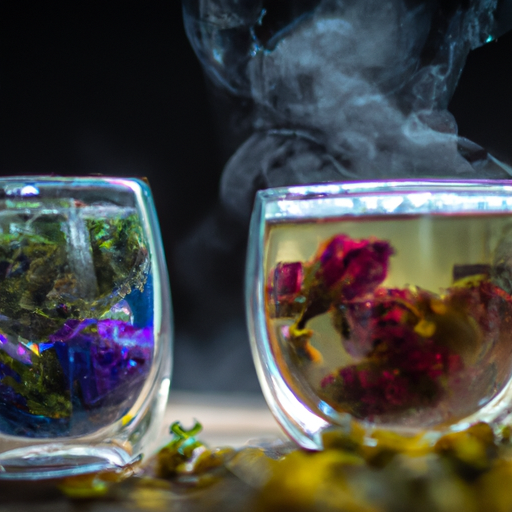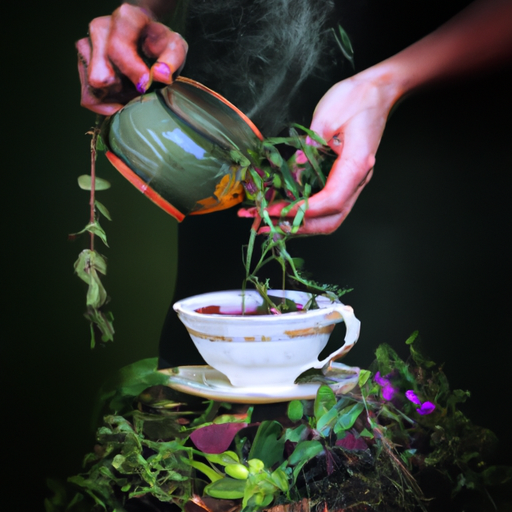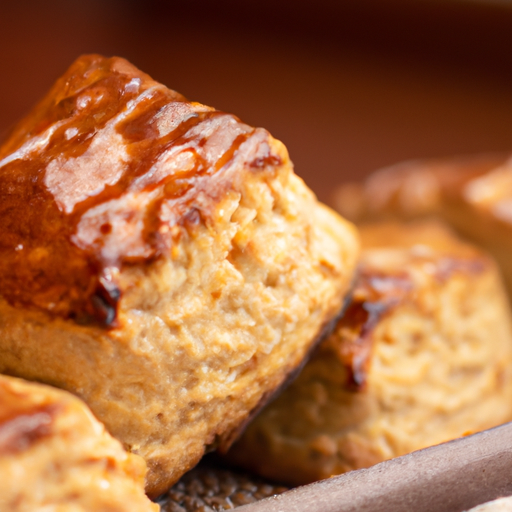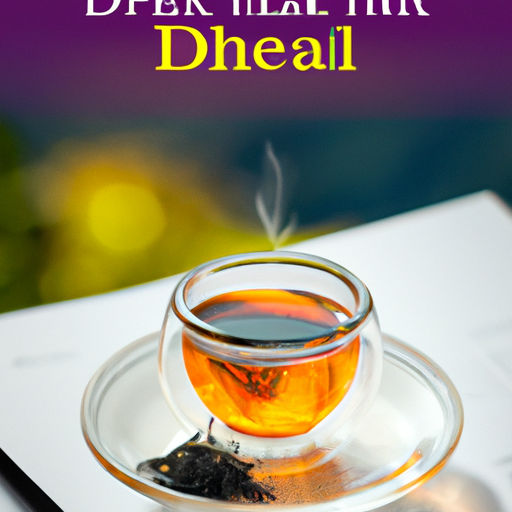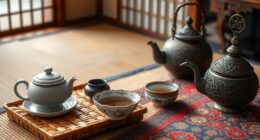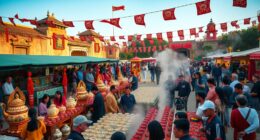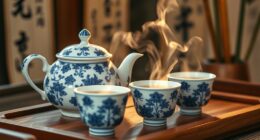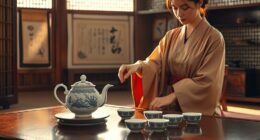In the vast world of tea, there are two contenders that reign supreme: green tea and herbal tea. Like two performers on a stage, they captivate our senses with their unique flavors and soothing qualities.
But, when it comes to the energizing power of caffeine, which tea takes the spotlight?
Imagine a delicate dance between the leaves of a tea plant and the brewing process, a symphony of flavors and aromas that awaken the senses. In this intricate performance, caffeine plays a key role, providing that much-needed boost to start the day or power through an afternoon slump.
But how do green tea and herbal tea compare in terms of caffeine content? Which one packs a stronger punch?
To unravel this mystery, we must delve into the world of tea, exploring its benefits, characteristics, and the factors that influence caffeine levels.
So, grab your favorite cup and join me on this journey of discovery as we determine which tea reigns supreme in the realm of caffeine.
Key Takeaways
- Green tea generally contains more caffeine than herbal tea.
- Herbal teas are typically caffeine-free or contain only trace amounts of caffeine.
- The caffeine content in tea is influenced by factors such as the type of leaves used and brewing time.
- Green tea may have a greater impact on sleep and digestion due to its caffeine content.
Understanding Caffeine Content in Tea
When it comes to understanding the caffeine content in tea, it’s essential to differentiate between green tea and herbal tea.
Both these tea varieties have different caffeine effects due to their distinct compositions. Green tea comes from the leaves of the Camellia sinensis plant, which contains caffeine. However, the caffeine content in green tea is relatively lower compared to other caffeinated beverages like coffee.
On the other hand, herbal tea refers to any infusion made from herbs, fruits, or flowers, and it does not naturally contain caffeine.
To determine which tea has more caffeine, it is important to consider the specific type of herbal tea being consumed. While most herbal teas are naturally caffeine-free, some blends may include ingredients like yerba mate or guayusa, which contain caffeine. However, these herbal teas still generally have lower caffeine content compared to green tea.
Green tea is known for its numerous health benefits and characteristics. It is rich in antioxidants, such as catechins, that have been linked to various health advantages, including improved brain function and reduced risk of heart disease. Additionally, green tea has a unique flavor profile that can vary depending on the specific type and processing method.
Transitioning into the subsequent section on the benefits and characteristics of green tea, it’s important to note that understanding the caffeine content in tea is just the first step in appreciating the overall qualities of green tea.
Benefits and Characteristics of Green Tea
Green tea has gained popularity due to its antioxidant properties, which can help protect the body against free radicals and oxidative stress. It’s also known for its potential health benefits, such as improving heart health, boosting metabolism, and reducing the risk of certain types of cancer.
I’ve researched extensively on the topic and can confidently say that incorporating green tea into your daily routine can be a smart and healthy choice.
Antioxidant Properties
Herbal tea, on the other hand, boasts a wide range of antioxidant properties, including polyphenols that can help protect against oxidative stress and potentially reduce the risk of chronic diseases. Antioxidants are compounds that neutralize harmful free radicals in the body, preventing damage to cells and tissues. They play a crucial role in maintaining overall health and well-being. Many herbal teas, such as chamomile, peppermint, and hibiscus, are rich in antioxidants and have been associated with various health benefits. For example, chamomile tea is known for its calming effects and may help reduce inflammation and improve sleep quality. Peppermint tea has been shown to relieve digestive issues and promote healthy digestion. Hibiscus tea, with its vibrant red color, is packed with antioxidants and may help lower blood pressure. These antioxidant benefits of herbal tea make it a great addition to a balanced diet. Transitioning into the next section, exploring the potential health benefits of herbal tea is intriguing.
Potential Health Benefits
Experience the potential health benefits of herbal tea as it enhances your well-being and leaves you feeling rejuvenated and revitalized. Herbal tea is known for its various potential health benefits.
It is rich in antioxidants, which may help reduce the risk of chronic diseases such as heart disease and cancer. Additionally, herbal tea can improve digestion, boost the immune system, and promote relaxation. However, it’s important to note that herbal teas can also have potential risks.
Some herbal teas may interact with certain medications or have adverse effects on certain individuals. It’s recommended to consult with a healthcare professional before incorporating herbal tea into your daily routine.
In terms of daily intake, it’s generally recommended to consume herbal teas in moderation, as excessive consumption may lead to unwanted side effects.
Moving forward, let’s explore the benefits and characteristics of herbal tea.
Benefits and Characteristics of Herbal Tea
One unique feature of herbal tea is its ability to provide a soothing and calming effect on the body. This is due to the presence of certain compounds, such as chamomile and lavender, that have natural relaxation properties.
Additionally, herbal tea comes in a wide variety of flavors, making it a versatile beverage for those who enjoy experimenting with different tastes. Whether you prefer the delicate floral notes of hibiscus or the refreshing minty aroma of peppermint, there’s a herbal tea flavor to suit every palate.
In addition to its diverse flavors, herbal tea also offers various health benefits. For example, certain types of herbal tea, such as ginger and echinacea, are known for their immune-boosting properties. Others, like chamomile and valerian root, can help promote better sleep and relaxation. Moreover, herbal teas are often caffeine-free, making them a suitable choice for individuals who are sensitive to caffeine or prefer to limit their intake.
Moving on to the next section about factors affecting caffeine levels in tea, it’s important to note that herbal teas generally have very low to no caffeine content. This is in contrast to green tea, which contains caffeine.
Factors Affecting Caffeine Levels in Tea
Surprisingly, the caffeine content in different types of tea can be influenced by a range of factors. One of the main factors that affects the caffeine levels in tea is the type of tea leaves used. For example, green tea leaves generally contain more caffeine compared to herbal tea leaves. However, the brewing time also plays a significant role in determining the caffeine levels in tea.
To understand how brewing time affects caffeine levels, let’s take a look at the table below:
| Brewing Time | Caffeine Content |
|---|---|
| 1 minute | Low |
| 3 minutes | Medium |
| 5 minutes | High |
| 7 minutes | Very High |
| 10 minutes | Extremely High |
As shown in the table, the longer the tea is brewed, the higher the caffeine content. This is because caffeine is released from the tea leaves during the brewing process. Therefore, if you prefer a tea with higher caffeine levels, you can brew it for a longer time.
Understanding the factors that affect caffeine levels in tea is essential when comparing the caffeine levels in green tea and herbal tea. This knowledge allows us to make informed choices about the tea we consume based on our preferences for caffeine content.
Comparing Caffeine Levels in Green Tea and Herbal Tea
If you’re curious about the caffeine content in your favorite teas, it’s time to explore the difference between these two popular options.
When comparing caffeine levels in green tea and herbal tea, it’s important to note that green tea generally contains more caffeine than herbal tea. Green tea comes from the Camellia sinensis plant, which contains caffeine naturally. On the other hand, herbal teas are made from a variety of plants and do not contain caffeine unless it is added separately.
The caffeine content in green tea can vary depending on factors such as the type of green tea, brewing time, and water temperature. On average, an 8-ounce cup of green tea contains around 25-45 milligrams of caffeine. In comparison, herbal teas are typically caffeine-free or contain only trace amounts. This makes herbal tea a suitable option for individuals who are sensitive to caffeine or looking to reduce their intake.
When it comes to the effects on sleep and impact on digestion, green tea may have a greater impact due to its caffeine content. Caffeine is a stimulant that can affect sleep quality, particularly if consumed in large quantities or close to bedtime. Additionally, caffeine can stimulate the production of stomach acid, potentially leading to digestive issues for some individuals.
Green tea generally contains more caffeine than herbal tea and may have a greater impact on sleep and digestion. However, it’s important to consider individual sensitivity to caffeine and personal preferences when choosing the right tea for your caffeine needs.
Choosing the Right Tea for Your Caffeine Needs
Deciding on the perfect brew to satisfy your caffeine cravings is like navigating a labyrinth of flavors and effects. When it comes to choosing tea flavors, it’s important to consider the caffeine content in different tea types. Here are two sub-lists that will help you make an informed decision:
Teas with High Caffeine Content:
- Black Tea: Known for its bold and robust flavor, black tea contains the highest amount of caffeine among all tea types. It can provide a strong energy boost.
- Oolong Tea: This semi-oxidized tea falls between green and black teas in terms of caffeine content. It offers a balance of flavors and moderate caffeine levels.
Teas with Low Caffeine Content:
- Green Tea: Renowned for its health benefits, green tea has lower caffeine levels compared to black tea. It provides a gentle energy lift and is rich in antioxidants.
- Herbal Tea: Unlike true teas, herbal teas are not derived from the Camellia sinensis plant. They are naturally caffeine-free, making them a great choice for those who are sensitive to caffeine or prefer to avoid it.
By considering the caffeine content in different tea types, you can choose the brew that suits your needs.
In the next section, we will discuss the conclusion: finding your perfect cup of tea.
Conclusion: Finding Your Perfect Cup of Tea
After thoroughly exploring the topic of choosing the right tea for your caffeine needs, it’s time to draw a conclusion and find your perfect cup of tea.
When it comes to the debate of green tea vs herbal tea and their caffeine content, it’s important to understand that green tea generally contains more caffeine than herbal tea. However, the exact amount can vary depending on the specific type of green tea or herbal tea you choose.
Now that we’ve established this, it’s time to delve into the exciting world of exploring different tea flavors. With countless options available, from delicate green teas to aromatic herbal blends, there is a tea out there for every palate. Whether you prefer a soothing chamomile or a bold matcha, experimenting with different flavors can be a delightful journey of discovery.
To ensure you brew the perfect cup of tea every time, here are a few tips to keep in mind. First, pay attention to water temperature and steeping time. Green teas generally require lower temperatures and shorter steeping times, while herbal teas can withstand higher temperatures and longer infusions. Second, invest in high-quality tea leaves or tea bags to maximize flavor. Finally, don’t be afraid to experiment with different brewing techniques and accessories like tea infusers or teapots.
By following these tips and exploring the vast array of tea flavors available, you’ll be well on your way to finding your perfect cup of tea. Cheers to delicious and satisfying tea moments!
Frequently Asked Questions
Is it safe to consume large amounts of green tea or herbal tea due to their caffeine content?
It is generally safe to consume moderate amounts of green tea or herbal tea during pregnancy, as long as caffeine intake is monitored. However, excessive consumption of caffeine can negatively impact sleep quality for both pregnant women and non-pregnant individuals.
Are there any health risks associated with consuming high levels of caffeine in green tea or herbal tea?
Consuming high levels of caffeine in green tea or herbal tea can pose health risks. It is important to be aware of the recommended daily intake and consider the potential negative effects on your health.
Can the caffeine content in green tea or herbal tea vary depending on the brand or quality of the tea?
Yes, the caffeine content in both green tea and herbal tea can vary depending on the brand or quality of the tea. Variations in caffeine content can be influenced by factors such as tea processing methods and the type of tea leaves used. Additionally, higher-quality teas tend to have a more consistent caffeine content.
How does the brewing time and temperature of green tea or herbal tea affect the caffeine levels?
Does the brewing time and temperature of green tea or herbal tea impact the taste, flavor profiles, overall health benefits, and antioxidant levels? By investigating this theory, I will provide evidence-based information to keep you interested and informed.
Are there any natural alternatives to green tea or herbal tea with lower caffeine content?
Yes, there are natural alternatives to green tea or herbal tea with lower caffeine content. Some options include chamomile tea, peppermint tea, and rooibos tea, which are all caffeine-free and can provide various health benefits.
Conclusion
After conducting extensive research and comparing the caffeine levels in green tea and herbal tea, it’s clear that green tea reigns supreme in terms of its caffeine content. With an impressive amount of caffeine that can give you a jolt of energy, green tea is the ultimate choice for those in need of a pick-me-up.
However, let’s not overlook the diverse and delightful flavors that herbal tea has to offer. While herbal tea may not have as much caffeine as green tea, it still provides a soothing and refreshing experience.
So, whether you’re looking for a caffeine boost or a moment of relaxation, both green tea and herbal tea have something unique to offer.

